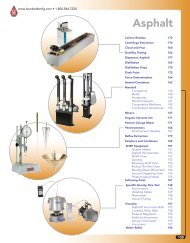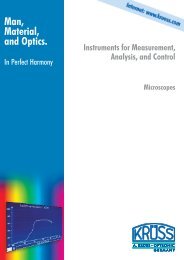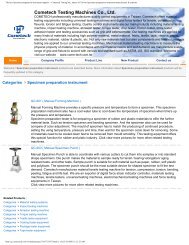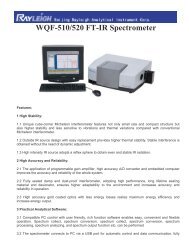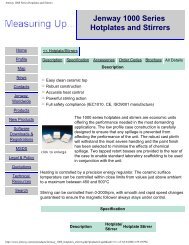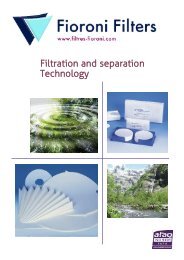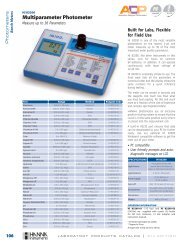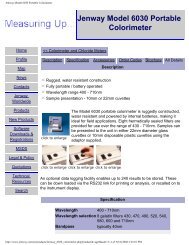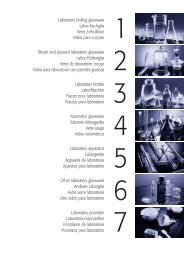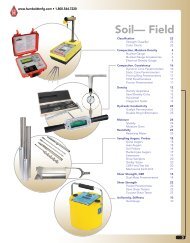Esco Labculture® Plus Class II Type A2 Biosafety Cabinet - Comlibris
Esco Labculture® Plus Class II Type A2 Biosafety Cabinet - Comlibris
Esco Labculture® Plus Class II Type A2 Biosafety Cabinet - Comlibris
You also want an ePaper? Increase the reach of your titles
YUMPU automatically turns print PDFs into web optimized ePapers that Google loves.
10<br />
KI Discus Containment<br />
Test According to EN 12469<br />
(Potassium Iodide)<br />
<strong>Esco</strong> is currently one of the few companies<br />
in the world equipped to perform the KI<br />
Discus test for our customers. The KI Discus<br />
test is defined in the European Standard<br />
for microbiological safety cabinets, EN<br />
12469, as a test method for validating the<br />
operator/personnel protection capabilities<br />
of the cabinet.<br />
• The KI Discus test shows excellent<br />
correlation with the microbiological<br />
test method for operator protection,<br />
and is useful for validating the actual<br />
containment performance of the cabinet<br />
on-site.<br />
• The KI-Discus takes only 45 minutes as<br />
opposed to 2 days for microbiological<br />
testing.<br />
• Thus, each <strong>Esco</strong> Labculture LB2 model<br />
is factory tested using the KI Discus<br />
method for operator safety.<br />
Purchase Specifications<br />
LB2 Series <strong>Class</strong> <strong>II</strong>, <strong>Type</strong> B2 (Total Exhaust)<br />
Biological Safety <strong>Cabinet</strong><br />
General Performance and Certifications<br />
1. The biological safety cabinet shall comply with<br />
one or more of the following international<br />
standards, and the manufacturer shall provide a<br />
certified copy of containment and performance<br />
tests equivalent to or greater than specified<br />
in the following independent international<br />
standards for biological safety, electrical and<br />
other functional characteristics: <strong>Class</strong> <strong>II</strong>, <strong>Type</strong><br />
B2 per NSF / ANSI 49 (USA).<br />
2. The cabinet shall protect (a) the operator<br />
and laboratory environment from particulates<br />
generated within the work zone; (b) the product<br />
and process within the work zone from airborne<br />
contamination from ambient air; (c) and the<br />
product and process within the work zone from<br />
cross contamination.<br />
3. Before shipment each cabinet shall be individually<br />
tested by the KI-Discus test (European Standard EN<br />
12469) to validate operator/personnel protection.<br />
The retention efficiency for the front aperture shall<br />
be not less than 99.999%. Microbiological testing<br />
for cabinet performance shall be performed on a<br />
statistical sampling basis.<br />
4. Each cabinet shall be listed by Underwriters’<br />
Laboratories (UL, CUL) or CE for electrical safety.<br />
5. Original documentation specific to each cabinet<br />
serial number shall be provided with the cabinet<br />
and maintained in the manufacturers’ records.<br />
Test data verifying all performance criteria shall<br />
be available upon request to include: (a) inflow<br />
velocity through direct inflow measurement<br />
method; (b) downflow velocity and uniformity;<br />
(c) filter leak scan with aerosol challenge for<br />
both filters; (d) light, noise, vibration; (e) and<br />
electrical safety.<br />
Filtration System<br />
6. The cabinet shall have one supply downflow<br />
filter and one exhaust filter. Supply filter shall<br />
be ULPA-type per IEST-RP-CC001.3 and meet<br />
EN1822 (H14) requirements. Exhaust filter shall<br />
be HEPA-type per IEST-RP-CC001.3 and meet EN<br />
1822 (H13) requirements.<br />
7. The filters shall be within an aluminum frame<br />
with mini-pleat design without aluminum<br />
separators; no wood or fiberboard shall be used<br />
in the filter assembly.<br />
8. Typical ULPA filter efficiency shall be >99.9997% at<br />
MPPS and 99.999% for 0.1 to 0.3 microns. Typical<br />
HEPA Filter shall be >99.99% at 0.3 microns.<br />
9. An integral filter guard shall be affixed to<br />
prevent damage to the filter media.<br />
10. The filters shall be (a) individually scan tested by<br />
the manufacturer, (b) individually scan tested after<br />
assembly, and (b) easily accessible for scan testing<br />
in situ by means of a dedicated upstream sampling<br />
port accessible from within the cabinet.<br />
11. The supply filter shall be angled and oriented<br />
to the 10° cabinet front angle to maximize<br />
downflow uniformity over the work surface.<br />
12. A removable, perforated metal diffuser shall<br />
be installed below the supply filter to optimize<br />
airflow uniformity and to protect from damage.<br />
Blower System<br />
13. The cabinet shall have a direct drive, permanently<br />
lubricated centrifugal blower/motor dynamically<br />
balanced in two planes compliant to ISO 2710<br />
for low noise, low vibration and long filter life.<br />
14. The blower/motor shall have an external rotor<br />
design and include an automatic thermal cut-out<br />
to disable the motor in case of overheating.<br />
15. The blower/motor shall have an automatic speed<br />
control to compensate for filter loading.<br />
16. The blower/motor system shall be enclosed<br />
within a dynamic chamber shaped steel plenum<br />
and integrated with the removable supply filter<br />
assembly to simplify filter changing.<br />
17. The cabinet shall be equipped with an integral<br />
exhaust collar for connection to the laboratory<br />
ducting system.<br />
<strong>Cabinet</strong> Design, Construction, Cleaning<br />
18. The cabinet shall be of triple wall design whereby<br />
all positive pressure plenums capable of handling<br />
contaminated air shall be surrounded by negative<br />
pressure. No positive pressure areas shall be<br />
accessible external to the cabinet. The third wall<br />
shall conceal utilities.<br />
19. The cabinet shall maintain containment<br />
performance even when removable work area<br />
components are removed for cleaning.<br />
20. The work tray shall be one-piece, removable,<br />
stainless steel with radius corners without crevices<br />
or joints.<br />
21. The cabinet shall have a stainless steel, onepiece<br />
fabricated drain trough with open angles<br />
to channel spills to a common drain.<br />
22. The closed sidewall shall be sealed without<br />
perforations, return air slots or concealed areas<br />
which can contain contaminants.<br />
23. The cabinet shall be free of sharp edges, nonfunctional<br />
protrusions, bolts, screws or hardware,<br />
and all metal edges shall be deburred.<br />
Ergonomics and Convenience<br />
24. The front sash shall be frameless to maximize<br />
visibility, and accessible for cleaning front and<br />
back. Sash glass shall be safety glass.<br />
25. The sash counterbalance shall be suspended on<br />
two high-strength cables, and the sash shall lock<br />
into position in the event one cable becomes<br />
detached.<br />
Biological Safety <strong>Cabinet</strong> • <strong>Class</strong> <strong>II</strong>, <strong>Type</strong> B2 (Total Exhaust) Biological Safety <strong>Cabinet</strong>s<br />
26. Magnetic, not mechanical, proximity sensors shall<br />
work in conjunction with the control system to<br />
indicate proper sash position for containment.<br />
27. Fluorescent lamps shall be mounted behind the<br />
control panel module out of the work zone.<br />
Electronic ballasts shall be used to eliminate<br />
flicker, extend lamp life and reduce heat output.<br />
28. The UV lamp, if installed, shall be mounted<br />
behind the control panel and away from the<br />
user’s line of site for protection. (Note: Does not<br />
apply to 1.8 meter/ 6 ft. model.)<br />
29. The UV lamp shall operate via an automatic<br />
timer with automatic shut-off managed by the<br />
microprocessor controller and shall be interlocked<br />
with the blower/motor and fluorescent lights for<br />
safety.<br />
30. The cabinet shall be designed with a 10° angled<br />
front to optimize user comfort, reduce glare and<br />
maximize reach into the work area.<br />
31. The front grille shall be raised to prevent airflow<br />
blockage and improve comfort.<br />
32. Penetrations for petcocks and service fittings<br />
shall be provided; penetrations shall be offset to<br />
improve user access.<br />
33. The cabinet shall accommodate an optional<br />
mounting stand for fixed-height.<br />
Control and Alarm System<br />
34. All cabinet functions shall be managed by a<br />
programmable microprocessor control system<br />
capable of software updates via Internet<br />
downloads.<br />
35. The microprocessor controller shall be mounted<br />
on the main control panel facing down toward<br />
the user.<br />
36. The controller shall include soft-touch keypad<br />
controls and backlit LCD displays to permit<br />
operation of the blower/motor, light, UV lamp,<br />
electrical outlet(s) and menu.<br />
37. The controller shall be user programmable<br />
in situ to enable or disable functions such as<br />
PIN (personal identification number) access<br />
restriction, cabinet start-up protocol, airflow<br />
alarm and other microprocessor controlled<br />
operations outlined in the user manual.<br />
38. When programmed ON, the start-up protocol<br />
shall perform an automatic pre-purge and postpurge<br />
cycle to ensure proper cabinet operation.<br />
39. The controller shall include a blower/motor hours<br />
meter to display aggregate motor running time<br />
to assist in predictive maintenance.<br />
40. Audible and visual alarms shall be provided for<br />
unsafe conditions such as improper airflow or<br />
sash position.<br />
41. Airflow shall be monitored by a temperature<br />
compensating, thermistor-based, true air velocity<br />
sensor mounted in the cabinet.<br />
42. The airflow display and alarm system shall be<br />
individually calibrated before shipment.<br />
43. The main control panel shall exhibit continuous<br />
display of air velocity and a 24-hour clock display.<br />
Certification, Service and Decontamination<br />
44. The cabinet shall be approved for both hydrogen<br />
peroxide vapor (HPV) and formaldehyde<br />
decontamination protocol.<br />
45. All panels leading to potentially contaminated and/<br />
or hazardous areas shall be color coded red.<br />
46. All components with the exception of blower/<br />
motor and ULPA filters shall be located outside<br />
of contaminated air spaces to facilitate servicing<br />
without the need to decontaminate the cabinet.<br />
47. All exterior surfaces shall be painted with a<br />
permanent antimicrobial inhibitor coating to<br />
minimize contamination.



